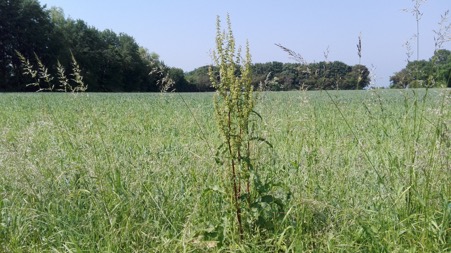JXB Volume 72, Issue 12 – Editor’s choice
JXB Volume 72, Issue 12 – Editor’s choice
This article highlights the following publication:
Optimization of timing of next-generation emergence in Amaranthus hybridus is determined via modulation of seed dormancy by the maternal environment
Rocio Belen Fernández Farnocchia, Roberto Luis Benech-Arnold, Anita Mantese, Diego Batlla
Journal of Experimental Botany, Volume 72, Issue 12, 28 May 2021, Pages 4283–4297, https://doi.org/10.1093/jxb/erab141

Wild plants such as this Amaranth species can become a considerable threat in agricultural crop production if left uncontrolled. Understanding its ecophysiology is therefore crucial for successful weed control management.
Mother plants control their offspring’s sprouting time
Uniform seed germination is a desired trait in agricultural crop production to maximize the yield potential. Equal seedling emergence throughout the field ensures, for example, the same degree of plant ripeness at harvest. Therefore, modern crop varieties have been bred and selected for rapid seed sprouting as soon as they are planted. Seeds of many weed species, by contrast, can remain dormant in the soil for years until they eventually see the light of day. Dormancy is an internal control mechanism that prevents seed germination under favourable conditions, for example by narrowing the thermal range permissive for sprouting. In this way, brief warm spells during winter are ignored and seeds germinate in spring when conditions are certainly adequate for seedling survival and plant reproduction. Weed appearance in the field is therefore hard to predict and highly problematic for farmers since they can severely reduce crop yields by competing for light, water, and nutrients especially during the critical period of seedling establishment. Increased use of herbicides, however, is no magic bullet for weed management: not only do they have damaging environmental and health effects, suboptimal timing of their application also increases the risk of weeds evolving herbicide resistance, as has happened for example for palmer amaranth (Amaranthus palmeri), which survives application of the most common agrochemicals and is thus a considerable cause for concern. It is therefore crucial to understand the physiology of seed dormancy and the complex network of its controlling factors to optimize weed management strategies.
In this issue of JXB Fernández Farnocchia et al. explore how sowing date and photoperiod experienced by the mother plant affect seed dormancy in the filial generation in Amaranthus hybridus. Maternal effects have already been observed in the lab in several wild species before but have rarely been tested under natural conditions. Several field studies were designed with different sowing dates throughout the year to cover a wide range of diverse temperature conditions and photoperiods experienced by the mother plants. Harvested seeds were subsequently exposed to different temperature regimes to test their level of dormancy at dispersal. Mother plants sown in mid-winter and thus growing under long day conditions produced seeds with high dormancy, whereas delays in maternal sowing shortened not only the vegetative and reproductive growth phase but also the photoperiod, and seeds showed low degree of dormancy. Maternal photoperiod could thus be a significant factor underlying differences in seed dormancy that are observed in response to changes in sowing date. Interestingly, significant correlations were also found with seed coat thickness: the later the sowing and the shorter the photoperiod, the thinner the coats. Coat-imposed dormancy could therefore be one of the physiological mechanisms underlying the maternal regulation, since coat properties have been shown to play important roles in germination control, for example by determining the mechanical restraint imposed on the developing embryo. In the field, differences in dormancy level established during seed maturation in various maternal environments leads to synchronized germination with the photoperiod experienced by the mother plant being a clear seasonal cue and the main driver behind this phenomenon. Consequently, the peaking germination rate during spring and early summer makes A. hybridus a strong competitor and thereby maximizes its population fitness. The authors emphasize that integrating environmental maternal effects into weed emergence models is crucial for correct prediction of dormancy release and thus successful weed control management.
Mareike Jezek
